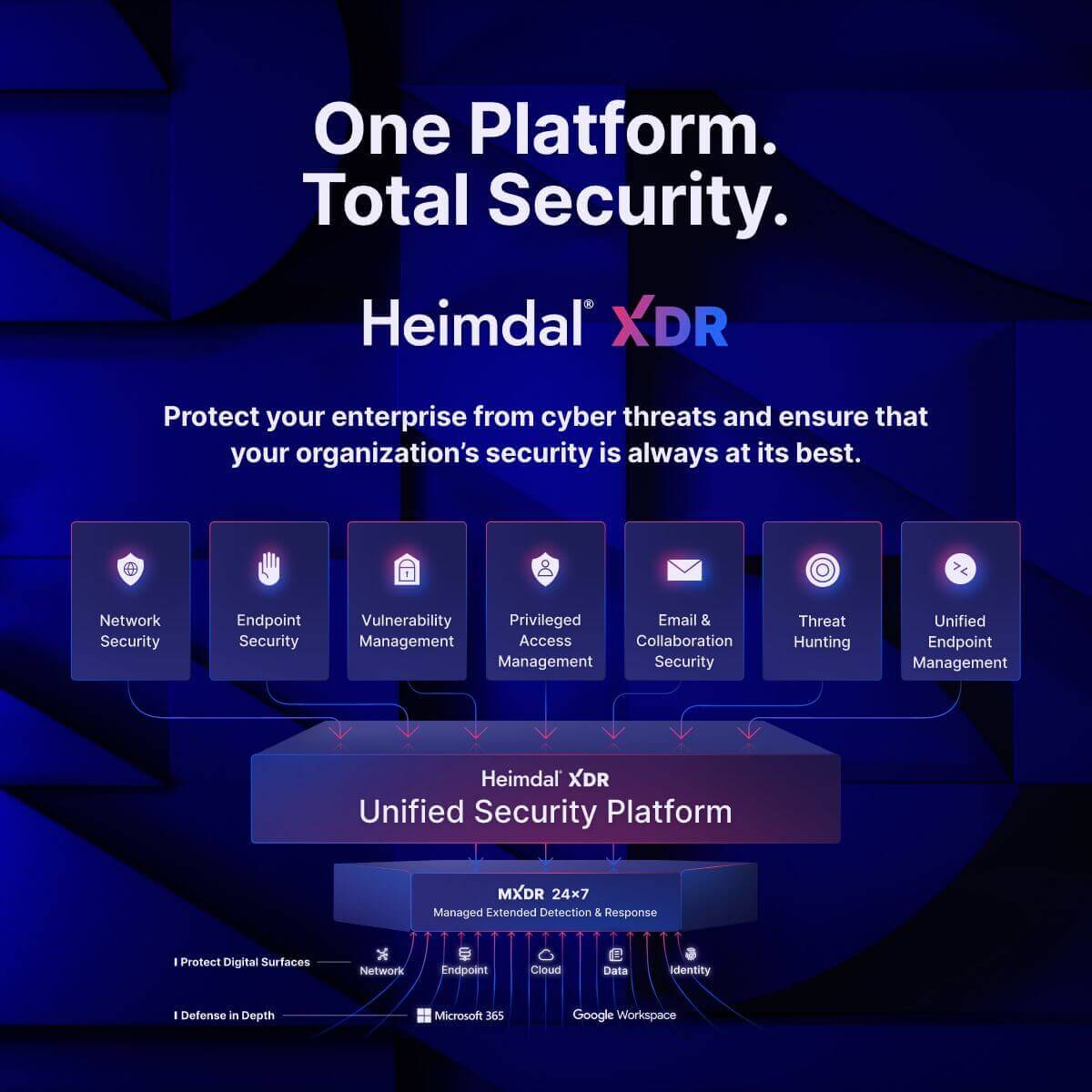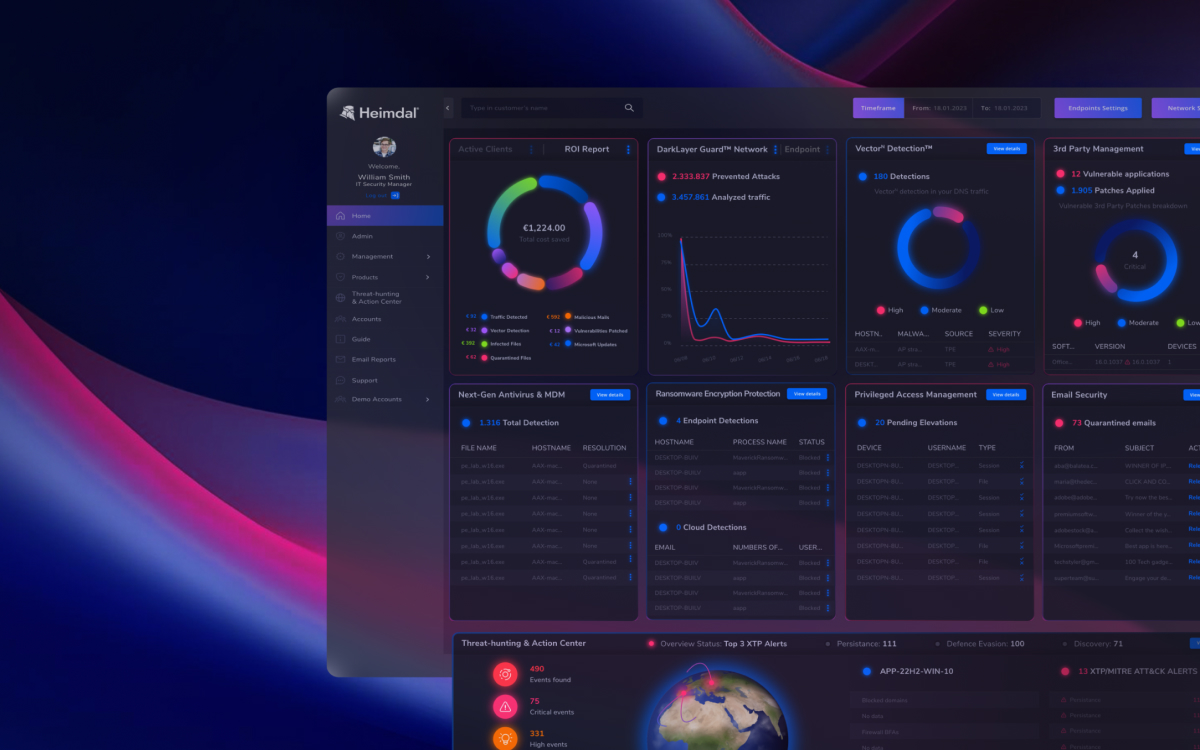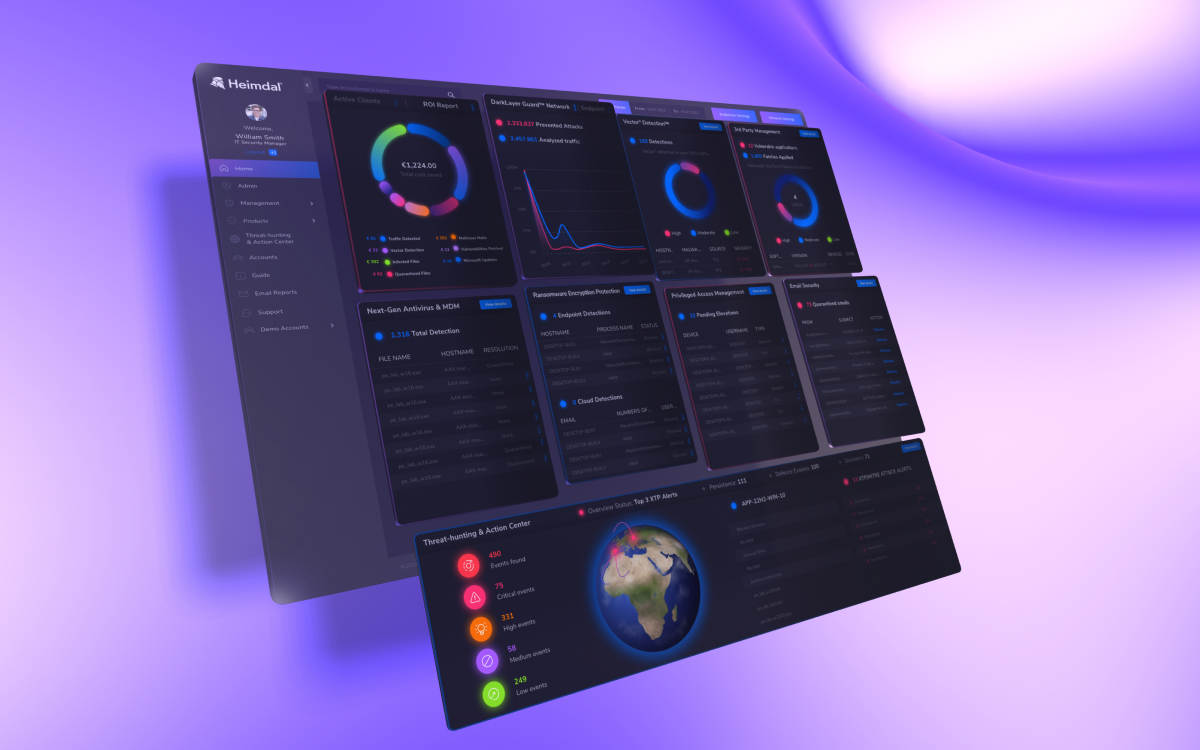Contents:
For decades cybersecurity professionals relied on point solutions to protect their system. Whether for patch management, network security, threat hunting, or anything else, specialized tools were purchased from vendors to deal with specific risks.
But in the last couple of years, that’s started to change. A growing number of IT departments, MSPs, and SOCs are turning to cybersecurity platforms – and leaving point solutions behind.
A cybersecurity platform can be transformative for any organization’s security operations as it prevents agent fatigue. Here’s everything you need to know about cybersecurity platforms.
Key takeaways:
- Consolidation beats complexity – Platforms replace siloed tools with unified visibility.
- Automation is essential – Automating tasks speeds up threat response.
- Cost and efficiency gains – Cybersecurity platforms cut overlap, boost consistency, and reduce costs.
- AI makes platforms smarter – AI-powered platforms detect threats faster, reduce manual work, and improve decision-making.
- Switching to a cybersecurity platform requires strategy – Switching to a platform can bring resistance and learning curves. A gradual rollout strategy (“land and expand”) often works best.
- Future-proof security – Platforms scale, evolve, and suit all business sizes.
What Is a Cybersecurity Platform?
A cybersecurity platform is a consolidated and unified suite of security solutions supplied by a single vendor. From a central hub, IT professionals, security operations center (SOC) staff, or managed services providers (MSPs) get access to multiple security tools that work seamlessly together. Instead of purchasing separate tools from separate vendors, a cybersecurity platform gives the organization all the security tools they need in one place.
Rather than having to log into different point solutions each time you want to carry out a security task, a cybersecurity platform lets you do it all from a single hub.
In a 2024 interview, Heimdal’s Founder and Chairman, Morten Kjaersgaard, explained the concept with an analogy:
It’s like getting in your car if you had 10 different cars. Clearly, you’re only going to be using one or two of them per day.But if you have all those components of all those cars in one place you can get the maximum output. Imagine you when you wanted to convert your Rolls Royce to a BMW while driving on the road.
That’s exactly the opportunity [of a cybersecurity platform].
Core Components of a Cybersecurity Platform
A true cybersecurity platform must provide certain core components, as well as a number of other important – but not strictly essential – features.
Core Features of a Cybersecurity Platform
To truly be considered a cybersecurity platform, a solution must offer:
A Central Hub
This is the core of a cybersecurity platform. All other solutions feed data into this dashboard to keep users informed. From the hub, users can directly access specific point solutions at the click of a button (without having to login to multiple environments).
Automation and Collaboration
There’s minimal value in using a cybersecurity platform if commands and actions cannot be automated across all the sub-apps and tools. Fundamentally, a cybersecurity platform allows multiple security apps to work seamlessly together.
Essential Cybersecurity Solutions
A cybersecurity platform must provide instant access to numerous point solutions so users can perform all (or at least the majority) of security tasks from one place. You should expect a platform to offer tools for all major tasks, including:
- Network security;
- Endpoint security;
- Endpoint management;
- Vulnerability management;
- Patch and asset management;
- Privileged access management;
- Application control;
- Email security;
- Collaboration app security;
- Threat hunting.
Additional Features of a Cybersecurity Platform
In addition to these core elements, some cybersecurity platforms provide extra features and properties which allow users to get more value from them.
Artificial Intelligence and Machine Learning
AI and ML streamline processes, helping users make decisions faster, discover problems even quicker, and help analyze risks.
Connect to third party vendors
Some cybersecurity platforms aim to be exclusive – customers can only use the vendor’s solutions. Others allow you to include information and data from third-party point solutions (e.g. Microsoft Defender) if you need.
Key Benefits of a Cybersecurity Platform
Cybersecurity platforms provide organizations with multiple benefits. A 2024 research study in the International Journal of Information Technology, Research and Applications analyzed other other academic studies and case reports to explore the effects of the platform approach.
In the article, the author explains:
The proliferation of standalone solutions often leads to inefficiencies, increased costs, and gaps in security coverage. It will lead to data silos, manual workarounds, and fragmented processes.
The presence of data silos impedes smooth integration, resulting in challenges when attempting to access and utilize data across the entire organization.
Cybersecurity platform consolidation emerges as a strategic approach to address these challenges (our emphasis).
Here are some of they key benefits of a cybersecurity platform, according to the academic research:
- Avoid functional overlap: Often, you’ll be paying for two point solutions that have several features in common, resulting in redundancy. A cybersecurity platform eliminates that.
- Accelerated incident detection: With an AI-powered cybersecurity platform, it is faster and easier to detect new threats, analyze them, and respond to them.
- Reduce coverage gaps: Relying on multiple point solutions means you may still have security coverage gaps between them. People will tend to work in silos, and this is a fast way to loosing visibility and slowing down incident response. A well-designed cybersecurity platform minimizes this risk.
- More consistent: Using a single, centralized platform allows tasks to be carried out more consistently – be that patching, endpoint security or privileged access management tasks.
- Cost efficient: Why pay for 10 point solutions, when a cybersecurity platform does it all, in one place, for less money?
- Scalable: A cybersecurity platform can easily scale as you grow. It’s much harder to scale if you need to protect all new users and devices with multiple different point solutions.
- Holistic approach to risk: Rather than focusing on one threat at a time, cybersecurity platforms allow you to see the bigger picture.
- Improved productivity and morale: The journal article also noted that SOC staff who use a cybersecurity platform are more productive and have improved morale.
Related: Why MSPs Are Moving to the Cybersecurity Platform Model
What Does it Look Like?
A consultant at a European software company describes how using Heimdal’s cybersecurity platform benefits their business:
The combined power of DNS filtering, vulnerability management, antivirus, ransomware encryption protection, and privilege escalation and delegation management has formed a formidable defense against a range of threats… This newfound resilience provides us with peace of mind.
Read the full case study here.
How to Choose the Right Cybersecurity Platform
The cybersecurity platform market is growing fast. How should you choose your solution? Here are some key considerations:
Integration with your systems and processes
Does the cybersecurity platform integrate with all apps, operating systems and endpoints you use? Just as importantly, does it integrate with your work processes? For example, if your company mainly collaborates using email, then a solution offering email security is obviously essential (most cybersecurity platforms offer this). But what if you mainly collaborate on Slack? You’ll need a solution that can manage this too.
Alignment with your business goals
Does the cybersecurity platform align with your short and long term business goals? Today you might mainly be using Windows so choose a Windows-only platform. But what if you hire MacOS-dependent designers in future? Or what if you expand your headcount rapidly in multiple geographies? The platform needs to be able to fit around your changing business.
Is it open enough?
A potential drawback of cybersecurity platforms is that they push businesses towards vendor lock-in. Being overly-reliant on one platform could mean a company doesn’t have access to all the tools it needs. However, some cybersecurity platforms use APIs to connect with additional point solutions, allowing customers to extend their platform when required.
Learn more: 11 Cybersecurity Platforms You Should Know About [2025]
Implementation Strategies for Cybersecurity Platforms
As with any new IT system, the introduction of a cybersecurity platform requires an implementation, rollout and adoption strategy. There are two broad approaches here.
- ‘One and done’ migration
This involves completely replacing all existing point solutions with a single platform in one fell swoop.
Advantages: Clean, fast and most efficient
Disadvantages: Learning curve, employee pushback
- ‘Land and expand’
Begin using one of the cybersecurity platform’s point solutions. Over time, start using additional apps as the need arises.
Advantages: Easier learning curve, less disruption
Disadvantages: Less efficient, can get bogged down, may costs more initially if you continue using other point solutions
Besides the implementation process, it’s also vital to focus on adoption. Keep your security teams on board with education, discuss their concerns, and develop a plan collaboratively.
Learn more: Why Unified Endpoint Management is Non-Negotiable for IT teams in 2025
Challenges and Solutions in Cybersecurity Platform Adoption
At Heimdal, we’ve seen dozens of our customers successfully implement our Extended Detection and Response cybersecurity platform. Here are a few of the key challenges we see companies come up against – and how to respond to them.
Existing contracts
Many cybersecurity point solutions have strict contractual clauses which aim to restrict early exit. Where it’s not possible to leave contracts early, the ‘land and expand’ strategy described above is the next best option.
Stakeholder resistance
Sometimes employees, end users or customers (if you’re an MSP) may be resistant to abandoning a preferred point solution. While it’s important to convince them of the benefits of a unified approach, this isn’t always possible. Again, this is why it’s so valuable to choose an open cybersecurity platform which allows you to connect with other point solutions.
Learning curve
Learning to use an entire new platform can be time consuming and challenging. At a minimum, the vendor should offer comprehensive training and support, plus ‘self service’ documentation to resolve technical issues.
Future Trends in Cybersecurity Platforms
While the cybersecurity platform market is relatively young, it is growing fast. There are a number of trends we expect to emerge in the coming years:
- Further consolidation: Market leaders will continue to consolidate and expand, with more powerful, effective solutions.
- New markets: Today, cybersecurity platforms tend to mainly be used by MSPs and large multinationals with an SOC. But in future, we expect medium and small sized businesses to use these solutions more often.
- Growing toolkit: Cybersecurity platforms must continually innovate, adding new point solutions to ensure customers are protected from emerging threats.
- Expansion of AI: AI and ML will be used in ever greater depth to harness the power of cybersecurity platforms.
Heimdal’s Cybersecurity Platform: Introducing XDR

Heimdal’s XDR is the world’s largest, most comprehensive cybersecurity platform. It offers a complete set of point solutions, which can be managed from a single, user-friendly dashboard. In addition to a wide variety of security tools, it also allows you to import data from third party point solutions via APIs.
It just works. We use Patch Management, E-mail Security and Remote Desktop modules from the Heimdal portfolio. All these products run through a single agent and consistently perform well.
What Makes Heimdal XDR the Ideal Cybersecurity Platform for You?

We’re confident Heimdal XDR is the most comprehensive cybersecurity platform on the market. Here’s why:
- All major cybersecurity solutions in one place;
- AI and ML threat intelligence;
- Instant, unified intelligence;
- Automated threat response and task management;
- APIs to most third-party point solution vendors;
- World-class, 24/7, global support;
- Continually evolving.

Ready to begin your journey to a complete cybersecurity platform? Request a demo today.
If you liked this article, follow us on LinkedIn, Reddit, X, Facebook, and Youtube.










 Network Security
Network Security
 Vulnerability Management
Vulnerability Management
 Privileged Access Management
Privileged Access Management  Endpoint Security
Endpoint Security
 Threat Hunting
Threat Hunting
 Unified Endpoint Management
Unified Endpoint Management
 Email & Collaboration Security
Email & Collaboration Security












